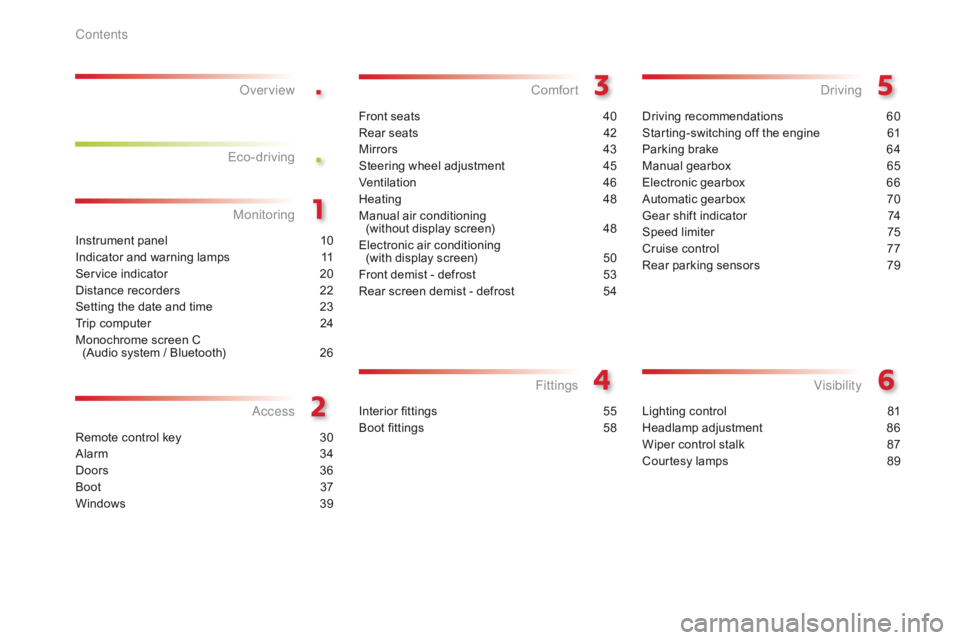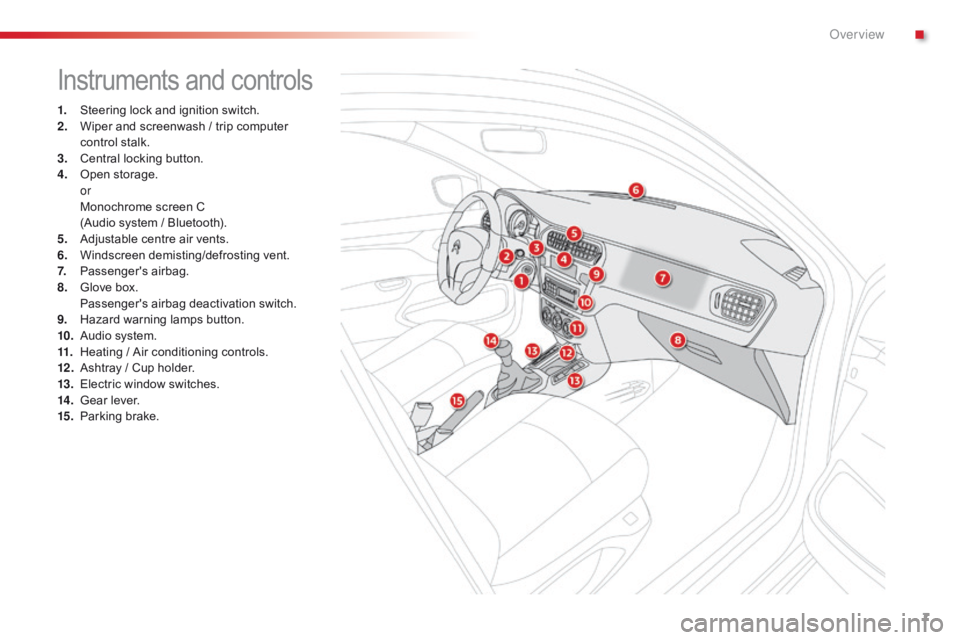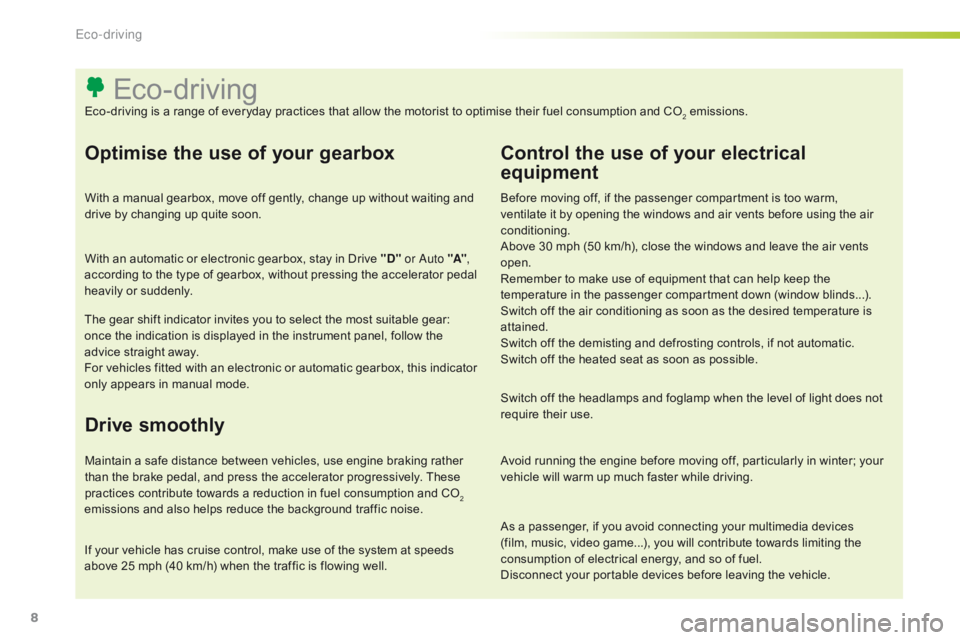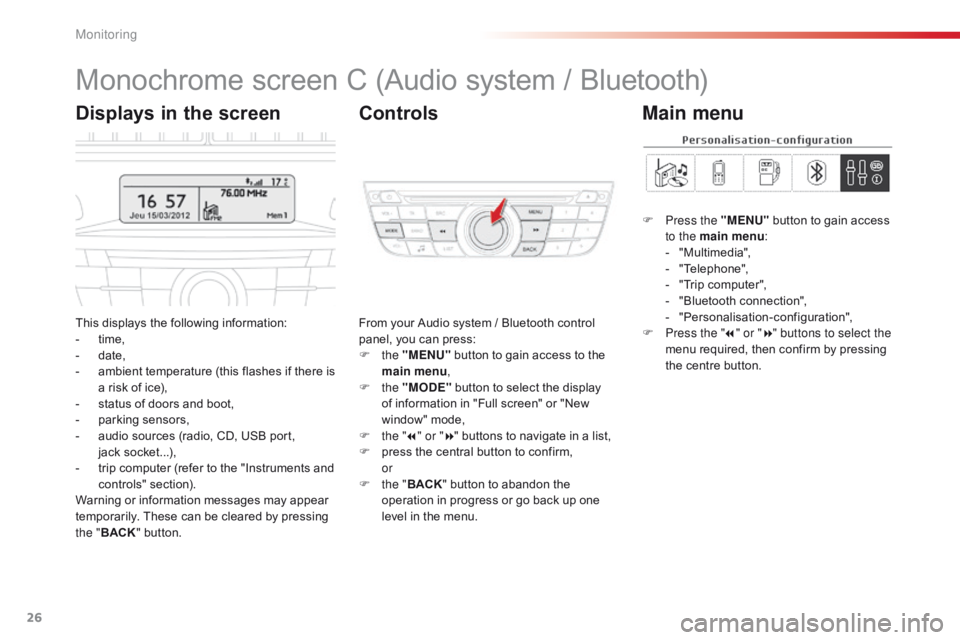window CITROEN C-ELYSÉE 2016 Handbook (in English)
[x] Cancel search | Manufacturer: CITROEN, Model Year: 2016, Model line: C-ELYSÉE, Model: CITROEN C-ELYSÉE 2016Pages: 330, PDF Size: 19.96 MB
Page 4 of 330

.
.
Instrument panel 10
Indicator and warning lamps
1
1
Service indicator
2
0
Distance recorders
2
2
Setting the date and time
2
3
Trip computer
2
4
Monochrome screen C (Audio system / Bluetooth)
2
6
Monitoring
ove
r view
Remote control key 3
0
Alarm
3
4
Doors
3
6
Boot
3
7
Windows
3
9
access
Front seats 40
Rear seats
4
2
Mirrors
4
3
Steering wheel adjustment
4
5
Ventilation
4
6
Heating
4
8
Manual air conditioning
(without display screen)
4
8
Electronic air conditioning (with display screen)
5
0
Front demist - defrost
5
3
Rear screen demist - defrost
5
4
Comfort
Driving recommendations 60
Starting-switching off the engine
6
1
Parking brake
6
4
Manual gearbox
6
5
Electronic gearbox
6
6
Automatic gearbox
7
0
Gear shift indicator
7
4
Speed limiter
7
5
Cruise control
7
7
Rear parking sensors
7
9
Driving
Lighting control 81
Headlamp adjustment
8
6
Wiper control stalk
87
C
ourtesy lamps
8
9
Visibility
Eco-driving
Interior fittings 5
5
Boot fittings
5
8
Fittings
Contents
Page 9 of 330

7
C-Elysee_en_Chap00b_vue-ensemble_ed01-2014
Instruments and controls
1. Steering lock and ignition switch.
2. Wiper and screenwash / trip computer
control stalk.
3.
C
entral locking button.
4.
O
pen storage.
or
M
onochrome screen C
(Audio system / Bluetooth).
5.
A
djustable centre air vents.
6.
W
indscreen demisting/defrosting vent.
7.
P
assenger's airbag.
8.
G
love box.
P
assenger's airbag deactivation switch.
9.
H
azard warning lamps button.
10.
A
udio system.
11.
H
eating / Air conditioning controls.
12 .
A
shtray / Cup holder.
13.
E
lectric window switches.
14 .
G
ear lever.
15.
P
arking brake.
.
Over view
Page 10 of 330

8
As a passenger, if you avoid connecting your multimedia devices
(film, music, video game...), you will contribute towards limiting the
consumption of electrical energy, and so of fuel.
Disconnect your portable devices before leaving the vehicle.
Eco-driving
Eco-driving is a range of everyday practices that allow the motorist to optimise their fuel consumption and CO2 emissions.
Optimise the use of your gearbox
With a manual gearbox, move off gently, change up without waiting and
drive by changing up quite soon.
With an automatic or electronic gearbox, stay in Drive "D" or
a
u
to "A",
according to the type of gearbox, without pressing the accelerator pedal
heavily or suddenly.
The gear shift indicator invites you to select the most suitable gear:
once the indication is displayed in the instrument panel, follow the
advice straight away.
For vehicles fitted with an electronic or automatic gearbox, this indicator
only appears in manual mode.
Drive smoothly
Maintain a safe distance between vehicles, use engine braking rather
than the brake pedal, and press the accelerator progressively. These
practices contribute towards a reduction in fuel consumption and CO
2
emissions and also helps reduce the background traffic noise.
If your vehicle has cruise control, make use of the system at speeds
above 25 mph (40 km/h) when the traffic is flowing well.
Control the use of your electrical
equipment
Before moving off, if the passenger compartment is too warm,
ventilate it by opening the windows and air vents before using the air
conditioning.
Above 30 mph (50 km/h), close the windows and leave the air vents
open.
Remember to make use of equipment that can help keep the
temperature in the passenger compartment down (window blinds...).
Switch off the air conditioning as soon as the desired temperature is
attained.
Switch off the demisting and defrosting controls, if not automatic.
Switch off the heated seat as soon as possible.
Switch off the headlamps and foglamp when the level of light does not
require their use.
Avoid running the engine before moving off, particularly in winter; your
vehicle will warm up much faster while driving.
Eco-driving
Page 28 of 330

26
Monochrome screen C (Audio system / Bluetooth)
This displays the following information:
- t ime,
-
d
ate,
-
a
mbient temperature (this flashes if there is
a risk of ice),
-
s
tatus of doors and boot,
-
p
arking sensors,
-
a
udio sources (radio, CD, USB port,
jack
s
ocket...),
-
t
rip computer (refer to the "Instruments and
controls" section).
Warning or information messages may appear
temporarily. These can be cleared by pressing
the " BACK " button. From your Audio system / Bluetooth control
panel, you can press:
F
the "MENU" button to gain access to the
main menu ,
F
the "MODE" button to select the display
of information in "Full screen" or "New
window" mode,
F
t
he "7" or " 8" buttons to navigate in a list,
F
p
ress the central button to confirm,
or
F
t
he "BACK " button to abandon the
operation in progress or go back up one
level in the menu.
Displays in the screen Controls
F Press the "MENU" button to gain access
to the main menu :
-
"
Multimedia",
-
"
Telephone",
-
"
Trip computer",
-
"
Bluetooth connection",
-
"
Personalisation-configuration",
F
P
ress the " 7" or " 8" buttons to select the
menu required, then confirm by pressing
the centre button.
Main menu
Monitoring
Page 41 of 330

39
C-Elysee_en_Chap02_ouvertures_ed01-2014
Windows
Electric controls Manual controls
The electric window switches remain
operational for about 45 seconds after
switching off the ignition or until a front
door is opened. During this period of
45 seconds, if you open a door while
operating a window, the window stops.
Operating the switch again has no
effect until the ignition is switched on
again.Always remove the key from the ignition
when leaving the vehicle, even for a
short time.
In the event of contact during operation
of the windows, you must reverse the
movement of the window. To do this,
press the switch concerned.
When operating the passenger electric
window switches, the driver must
ensure that no one is preventing correct
closing of the windows.
The driver must ensure that the
passengers use the electric windows
c o r r e c t l y.
Be particularly aware of children when
operating the windows.
1.
L
eft hand front electric window.
2.
R
ight hand front electric window.
3.
R
ight hand rear electric window.
4.
L
eft hand rear electric window.
5.
D
eactivating the rear electric window
switches .
To open or close the window, press or pull the
switch. The window stops as soon as the switch
is released.
Turn the window winder located on the door
trim panel.
Deactivating the rear window
controls
For the safety of your children, press switch 5
t o prevent operation of all of the windows,
irrespective of their position.
With the warning lamp on, the switches are
deactivated. With the warning lamp off, the
switches are active.
Model with front electric windows
Model with front and rear electric windows
2
Access
Page 48 of 330

46
Ventilation
Air intake flow
The incoming air follows various paths
depending on the controls selected by
the
d
river:
-
d
irect arrival in the passenger
compartment (air intake),
-
p
assage through a heating circuit (heating),
-
p
assage through a cooling circuit (air
conditioning).
Control panel
The controls of this system are grouped
together on control panel A on the centre
console. 1.
W
indscreen demisting-defrosting vents.
2.
F
ront side window demisting-defrosting
vents.
3.
S
ide adjustable air vents.4.
C
entral adjustable air vents.
5.
A
ir outlets to the front footwells.
6.
A
ir outlets to the rear footwells.
Air distribution
Air intake
The air circulating in the passenger compartment
is filtered and originates either from the outside via
the grille located at the base of the windscreen or
from the inside in air recirculation mode.
Comfort
Page 51 of 330

49
3. Air distribution adjustment
Windscreen and side windows.
Windscreen, side windows and
footwells.
Footwells.
Centre and side air vents, footwells.The air distribution can be adapted
by placing the control knob in an
intermediate position or by closing
the vents. F
M
ove the manual control to the
right to return to the "Exterior air
intake" position.
F
M
ove the manual control to the
left for the "Recirculation of
interior air" position.
5. Air conditioning On / Off
It enables you to:
- l ower the temperature, in summer,
-
i
ncrease the effectiveness of the demisting
in winter, above 3 °C.
Switching on
F Press the button 5 , the associated indicator
lamp comes on.
Switching off
F Press the button 5 again, the associated indicator lamp goes off.
Switching off may affect comfort levels
(humidity, condensation). The air conditioning is designed to
operate effectively in all seasons,
with the windows closed.
The air conditioning does not operate
when the air flow adjustment control 2
is in position " 0".
To obtain cooled air more quickly, you can use
recirculation of interior air for a few moments.
Then return to fresh air intake.
Centre and side vents.
4. Air intake / Air recirculation
The recirculation of interior air insulates the
passenger compartment from exterior odours
and smoke.
Return to exterior air intake as soon as possible
to prevent deterioration of the air quality and
the formation of mist.
3
Comfort
Page 53 of 330

51
4. Air conditioning On/Off
F Press the "A /C " button, the
symbol in the air conditioning
screen comes on.
Switching off
This button allows the rapid
cooling of the air in the passenger
compartment.
5. Air conditioning: A/C MAX button
Switching on
F Press the "A /C MA X" button, the symbol in the air conditioning screen comes on.
F
P
ress the "A /C " button again, the symbol
in the air conditioning screen goes off.
Switching off may lead to unpleasant conditions
(humidity, misting).
Switching on
Switching off
F Press the "A /C MA X" button again, the symbol in the air conditioning screen goes
of f.
6. Air distribution adjustment
F Press this button successively to direct the air flow towards:
-
w
indscreen and side windows
(demisting or defrosting),
-
w
indscreen, side windows and
air vents,
-
w
indscreen, side windows, air
vents and footwells,
-
w
indscreen, side windows and
footwells,
-
f
ootwells,
-
a
ir vents and footwells,
-
a
ir vents.
3
Comfort
Page 55 of 330

53
Front demist - defrost
These markings on the control panel indicate the control positions for rapid demisting or
defrosting of the windscreen and side windows.
With the heating /
ventilation systemWith the manual air
conditioning system
(without screen)With electronic air
conditioning (with screen)
F Put the temperature and air flow controls to
the dedicated marked position.
F
P
ut the air intake control to the "Exterior air
intake" position
(
manual control moved to the right).
F
P
ut the air distribution control to the
"Windscreen" position. F
P ress this button. T
he lamp in the button comes on.
F
P
ress this button again to switch
it off.
T
he lamp in the button goes off.
F
P ut the temperature and air flow controls to
the dedicated marked position.
F
P
ut the air intake control to the "Exterior air
intake" position
(
manual control to the right).
F
P
ut the air distribution control to the
"Windscreen" position.
F
S
witch on the air conditioning by pressing
the appropriate button; the lighting of the
associated control comes on.
3
C
Page 56 of 330

54
Rear screen demist - defrost
The control button is located on the heating / ventilation or air conditioning system control
panel.
Switching on
The rear screen demisting/defrosting can only
operate when the engine is running.
F
P
ress this button to demist /defrost the
rear screen and (depending on version)
the door mirrors. The indicator lamp
associated with the button comes on.
Switching off
The demisting/defrosting switches off
automatically to prevent an excessive
consumption of current.
F
I
t is possible to stop the demisting/
defrosting operation before it is switched
off automatically by pressing the button
again. The indicator lamp associated with
the button goes off.
F
S
witch off the demisting/defrosting of the
rear screen and door mirrors, if fitted,
as soon as appropriate, as lower current
consumption results in reduced fuel
consumption.
Heated lower windscreen*
In cold conditions, the heated rear window
switch also allows the lower windscreen to be
heated, so as to free the wiper blades when
frozen to the glass by frost or snow.
The function is active when the ambient
temperature is below 0°C.
* Depending on country of sale.
Comfort